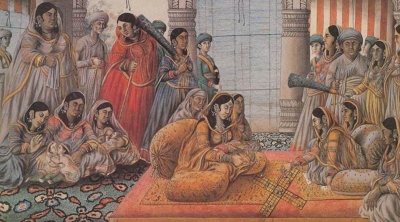
The origin
When Babur, the first Mughal emperor came thundering into India, he brought his ‘haraman’, his household with him, including wives, children, mothers, grandmothers, elderly widowed aunts, unmarried relatives and so on. These Turki women were hardy – they lived in tents, rode on horseback accompanying the army and mingled with everyone, and indeed, matriarchs were greatly respected and looked to for advice.
However, during Akbar’s long, stable reign, the concept of a physically separate, private place for Mughal royal ladies started. As Akbar made a great many marriage alliances with the Rajput princesses in his endeavour to get the support of their fathers, his household exploded in size, since each princess would come to him with a large number of attendants to keep her company.
A Glided Cage
An enclosed area of the royal compound called the harem, mahal or zenana became the world of Mughal women. Over time, the separation became complete. Mughal royal ladies started observing full purdah (meaning ‘curtain’ in Persian) – it became utterly shameful for them to see or be seen by any unrelated man who wasn’t the emperor himself. The zenana was soon heavily-guarded – not by men, but by eunuchs. On the rare occasion that the royal ladies had to venture outside, it was under heavy veils and in closely covered palanquins. If an unrelated man was found trying to enter this sacrosanct space, he could (and often would) be put to death straight away!
Inside this royal bubble and the mahal, life was totally different, where the women could walk around freely, unveiled. Thousands of women lived their entire lives in this luxurious, opulent, gilded cage. In addition to the many official wives of the emperor, were hundreds of ‘semi-official’ ones, as well as grandmothers, step-mothers, aunts, sisters, daughters, nieces and so on. Children were brought up in the harem, until the boys had to move out in their teenage years.
It was an entire world of its own, where the Mughal Emperor was the sun around which the women revolved. He could enter his harem whenever he pleased. The harem is where the Emperor went for privacy and relaxation. It is where he would take his meals, and where he would read his private documents.
Zenana Shenanigans
Life in the zenana was a bustling hive of activity and intrigue. Each lady had a personal allowance, and female slaves and servants hovered around to tend to every need. Royal karkhanas were set up just to make the finest muslin dresses for them, and royal jewelers did the rounds to fashion the most exquisite jewellery.
The ladies were educated, and many became patrons of culture – music, art and literature. They influenced fashions at the court. Some were writers and poets like Salima Sultana, Jahanara, and Aurangzeb’s daughter Zebunissa. Chess, a Mughal obsession, was as fiercely played inside the harem as at court.
Eager Europeans
European visitors to the Mughal court were both shocked and very curious about this setup which seemed very exotic to them.
European visitors were most curious to see the zenana for themselves but were not allowed anywhere close to it due to the heavy shroud of secrecy surrounding it.
Bernier, a French doctor, speaks of his attempts to get into the harem. “I have sometimes gone into it when the King was absent from Delhi, for the purpose of giving my professional advice when a great lady was so ill she could not be moved. A cashmere shawl covered my head, hanging like a scarf down to my feet, and a eunuch led me by hand as if I had been a blind man.”
Mostly they had to rely on hearsay from the eunuchs who served in the harem. “The apartments of the queens are magnificent; and whatever can contribute either to conscience or pleasure has been consulted in their arrangement. It may be said, that the ardour of a burning climate is never experienced in these abodes. Here are to be seen running streams, shadowy groves, fountains, and subterraneous grottos for securing the enjoyment of a delicious coolness.”
Meena Bazaar
Akbar started an annual event in the mahal that was carried on by all future emperors. The Meena Bazaar was a yearly fair held during the lavishly celebrated Parsi Navroz festivities, where instead of regular shopkeepers, the royal ladies and the wives of Mughal nobles would set up stalls to set luxuries and exotic items. The only made customer allowed in was the Emperor himself!
A French account says, “A whimsical kind of fair is held in the Mehale, conducted by the handsomest wives of the Omrahs…these bewitching females act the part of traders, while the purchases are the King, the Begums or the Princesses of the harem”. But to give an idea of how some nobility really felt about it: when Akbar was negotiating with a Rajput king, one of the conditions for the Rana’s surrender was that his women would be exempt from attending the Meena Bazaar!
Powerful Princesses
Royal Mughal Princesses would usually remain unmarried and spend their whole lives in the zenana. However, they could have enormous influence, and would ofen watch what was happening at court from behind intricate latticed screens and give their opinions to the emperors. Some also issued farmans (edicts). For instance, Jahanara was the great favourite of her father Shah Jahan and her brother Dara Shikoh. Her sister Roshanara on the other hand, was on Aurangzeb’s side and would spy on the harem and send him letters about what was happening. Jahangir’s wife Noorjahan practically ran the massive Mughal empire in his name for 15 years.
The mahal was a thriving hotbed of politics all around. Each royal lady would intrigue to become more powerful and influential than the next, and everyone competed to get the Emperor’s ear.’ There were quite as many plots and spies and treachery as in the Mughal court.
Picture Credit : Google

